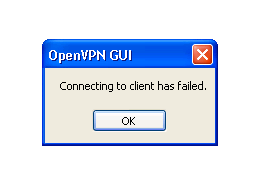

Edgerouter Openvpn Gui
Highlighted Articles Discussion Group | On This Page Troubleshooting this problem could be very simple: try connecting the VPN with and without 'Set nameserver' selected. If one way or the other solves your problem, you're done! OpenVPN is such a powerful tool with so many options, and computer configurations are so varied, that it is impossible to have an exhaustive troubleshooting guide. This guide is meant for the most common setups, so if it doesn't apply to your situation, or doesn't help, see the Support page for guidance. This page assumes that you are successfully connected to a VPN server. If not, or if you aren't sure, look at Common Problems. If OpenVPN is connected to the server but you can't access the InternetAfter connecting, if you can't reach the Internet, it's likely that your setup has
Tunnelblick includes the ability to diagnose some DNS problems and will warn you about some common configuration problems. Check for a DNS problem: If you don't have a DNS problem then there is something else going on. See the Support page for guidance. If you have a DNS problem:
How to check your DNS settings
Note: If the DNS server list is dimmed (grayed out), it was set via DHCP, not manually. How to use a different DNS serverThere are two ways to set up a different DNS server: Use a different DNS server whether or not a VPN is activeYou can set your computer up to use a different DNS server all the time. Google Public DNS is free, and OpenDNS has a free version. There are lots of others. To use such a DNS server all the time (whether or not a VPN is connected):
This will set up your computer to always (whether or not you are connected to the VPN) use two Google DNS servers and two OpenDNS servers (in that order). Substitute the addresses for the DNS provider of your choice if you want. Use a different DNS server only when the VPN is activeNote: This will only work if you specify 'Set nameserver' in Tunnelblick's settings for the configuration. Plex media server 1 18 1 1973 chevy. Add a line to your OpenVPN configuration file for each DNS server: ' If OpenVPN is connected to the server but your IP address does not changeIf you have a check in the 'Check if the apparent public IP address changed after connecting' checkbox on the 'Settings' tab of Tunnelblick's 'VPN Details' window, and your IP address doesn't change after connecting, a window will pop up to notify you. Iskysoft dvd creator 6 0 1 2 x 4. If OpenVPN connects to the server properly but your IP address does not change, your OpenVPN setup needs to include the '--redirect-gateway' option. By default, OpenVPN only sends some traffic through the VPN — traffic that is specifically destined for the VPN network itself. The '--redirect-gateway' option tells OpenVPN to send all IPv4 traffic through the VPN. There are three ways the option can be added; you need only use one:
(The '--' at the start of an OpenVPN option is omitted when the option appears in a configuration file.) How to test your IP addressYou can find out what IP address your computer is using by going to https://tunnelblick.net/ipinfo. The first number shown is your apparent public IP address: Note: tunnelblick.net does not use Javascript, other client-side scripting, plugins, trackers, beacons, or web bugs, and it does not carry advertising. It does not store cookies or any other data on your computer (except as noted in the tunnelblick.net privacy policy). If you have checked 'Check if the apparent public IP address changed after connecting', the IP address will be displayed in the Tunnelblick menu while you are connected: |
Gui Openvpn
OpenVPN is something of a standard in the open source world, but OpenVPN 2.4.3 represents only the VPN client portion of that equation. It's flexible and well managed and connects to a wide. OpenVPN GUI is a graphical front-end application for OpenVPN on Windows. It gives you an icon in the system tray from which you can control OpenVPN. The OpenVPN -user and -group options and openvpn-down-root.so. When using 'Set nameserver' or your own down script for OpenVPN, it is usually necessary to avoid using the OpenVPN 'user' and 'group' options in the configuration file.
